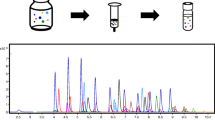Abstract
The growing impact of organic and inorganic pollutants on the environment has led to the development of numerous strategies to counteract this effect. Among all, green technologies such as phytoremediation, has won relevance for its low cost as well as being an eco-friendly and sustainable process. In the past years, tobacco hairy roots (HRs) have become a good example of the effectiveness of plants as a tool for removing different pollutants. In this sense, the understanding of the intracellular mechanisms involved in the phytoremediation process has become of great interest. Glycerophospholipids (GLPs) are a key factor on intracellular signaling, given that they can activate different pathways, despite there is not enough information available about their levels and fluctuation under certain stress conditions. The aim of this work was to develop of a new chromatographic method coupled to electrospray ionization tandem mass spectrometry (LC-ESI-MS/MS) with selected reaction monitoring (SRM) and data dependent scan detection for the evaluation of GLP profile after the exposure to phenol, to get a better understanding of lipids turnover and their effect on signaling pathways. This highly sensitive method allows the identification, separation and quantification in less than a 20 min-run of the eleven most relevant GPL species present in hairy tobacco root extracts after phenol exposure, and is suitable for evaluating small changes in GPL levels.




Similar content being viewed by others
Data Availability
Not applicable.
Code Availability
Not applicable.
References
Agostini E, Talano MA, González PS et al (2013) Application of hairy roots for phytoremediation: what makes them an interesting tool for this purpose? Appl Microbiol Biotechnol 97:1017–1030
Ludwig-Müller J, Xu J, Agostini E, Georgiev MI (2014) Root Eng 40:387–405. https://doi.org/10.1007/978-3-642-54276-3
Mehrotra S, Srivastava V, Rahman LU, Kukreja AK (2015) Hairy root biotechnology—indicative timeline to understand missing links and future outlook. Protoplasma 252:1189–1201. https://doi.org/10.1007/s00709-015-0761-1
Paisio CE, Agostini E, González PS (2019) Application of two bioassays as potential indicators of phenol phytoremediation efficiency by tobacco hairy roots. Environ Technol. https://doi.org/10.1080/09593330.2019.1649471
Kumar M, Mitra A (2017) Hairy root culture of Nicotiana tabacum (Tobacco) as a platform for gene manipulation of secondary metabolism. Prod Plant Deriv Nat Compd Hairy Root Cult. https://doi.org/10.1007/978-3-319-69769-7_8
Alderete LGS, Talano MA, Ibáñez SG et al (2009) Establishment of transgenic tobacco hairy roots expressing basic peroxidases and its application for phenol removal. J Biotechnol 139:273–279. https://doi.org/10.1016/j.jbiotec.2008.11.008
Alderete LGS, Ibáñez SG, Agostini E, Medina MI (2012) Phytoremediation of phenol at pilot scale by tobacco hairy roots. Int J Environ Sci 3:398–407. https://doi.org/10.6088/ijes.2012030131038
Paisio CE, Agostini E, González PS, Bertuzzi ML (2009) Lethal and teratogenic effects of phenol on Bufo arenarum embryos. J Hazard Mater 167:64–68. https://doi.org/10.1016/j.jhazmat.2008.12.084
Alderete LGS, Agostini E, Medina MI (2011) Antioxidant response of tobacco (Nicotiana tabacum) hairy roots after phenol treatment. Plant Physiol Biochem 49:1020–1028. https://doi.org/10.1016/j.plaphy.2011.07.009
Ibañez SG, Villasuso AL, Racagni GE et al (2016) Phenol modulates lipid kinase activities in Vicia sativa plants. Environ Exp Bot 122:109–114. https://doi.org/10.1016/j.envexpbot.2015.09.005
Alderete LGS, Racagni G, Agostini E, Medina MI (2012) Phospholipid turnover and phospholipase D activity in tobacco hairy roots exposed to phenol. Environ Exp Bot 77:141–145. https://doi.org/10.1016/j.envexpbot.2011.11.006
Alderete LGS, Racagni G, Agostini E, Medina MI (2019) Is the PLC pathway involved in the response to phenol treatment in tobacco hairy roots? Vitro Cell Dev Biol Plant 55:549–557. https://doi.org/10.1007/s11627-019-09968-4
Singh A, Bhatnagar N, Pandey A, Pandey GK (2015) Plant phospholipase C family: regulation and functional role in lipid signaling. Cell Calcium 58:139–146. https://doi.org/10.1016/j.ceca.2015.04.003
Hong Y, Zhao J, Guo L et al (2016) Plant phospholipases D and C and their diverse functions in stress responses. Prog Lipid Res 62:55–74. https://doi.org/10.1016/j.plipres.2016.01.002
Woodcock EA, Kistler PM, Ju YK (2009) Phosphoinositide signalling and cardiac arrhythmias. Cardiovasc Res 82:286–295. https://doi.org/10.1093/cvr/cvn283
Van Hoogevest P, Wendel A (2014) The use of natural and synthetic phospholipids as pharmaceutical excipients. Eur J Lipid Sci Technol 116:1088–1107. https://doi.org/10.1002/ejlt.201400219
Jing L, Xuling W, Ting Z et al (2015) A review on phospholipids and their main applications in drug delivery systems. Asian J Pharm Sci 10:81–98
Berry KAZ, Murphy RC, Kosmider B, Mason RJ (2017) Lipidomic characterization and localization of phospholipids in the human lung. J Lipid Res 58:926–933. https://doi.org/10.1194/jlr.M074955
Olsson P, Holmbäck J, Herslöf B (2012) Separation of lipid classes by HPLC on a cyanopropyl column. Lipids 47:93–99. https://doi.org/10.1007/s11745-011-3627-0
Cífková E, Holčapek M, Lísa M et al (2015) Determination of lipidomic differences between human breast cancer and surrounding normal tissues using HILIC-HPLC/ESI-MS and multivariate data analysis. Anal Bioanal Chem 407:991–1002. https://doi.org/10.1007/s00216-014-8272-z
Buszewski B, Noga S (2012) Hydrophilic interaction liquid chromatography (HILIC)-a powerful separation technique. Anal Bioanal Chem 402:231–247. https://doi.org/10.1007/s00216-011-5308-5
Mal M, Wong S (2011) A HILIC-based UPLC/MS method for the separation of lipid classes from plasma. Waters Appl Note 1–5
Schwalbe-Herrmann M, Willmann J, Leibfritz D (2010) Separation of phospholipid classes by hydrophilic interaction chromatography detected by electrospray ionization mass spectrometry. J Chromatogr A 1217:5179–5183. https://doi.org/10.1016/j.chroma.2010.05.014
Netto JD, Wong S, Ritchie M, High resolution separation of phospholipids using a novel orthogonal two-dimensional UPLC/QTof MS system configuration. Waters 1–8
Blanksby SJ, Mitchell TW (2010) Advances in mass spectrometry for lipidomics. Annu Rev Anal Chem 3:433–465. https://doi.org/10.1146/annurev.anchem.111808.073705
Pati S, Nie B, Arnold RD, Cummings BS (2016) Extraction, chromatographic and mass spectrometric methods for lipid analysis. Biomed Chromatogr 30:695–709. https://doi.org/10.1002/bmc.3683
Xu S-L, Wei F, Xie Y et al (2018) Research advances based on mass spectrometry for profiling of triacylglycerols in oils and fats and their applications. Electrophoresis 39:1558–1568. https://doi.org/10.1002/elps.201700481
Cajka T, Fiehn O (2014) Comprehensive analysis of lipids in biological systems by liquid chromatography-mass spectrometry. TrAC Trends Anal Chem 61:192–206. https://doi.org/10.1016/j.trac.2014.04.017
Murasnige T, Skoog F (1962) A revised medium for rapid growth and bio agsays with tohaoco tissue cultures. Physiol Plant 15:473–497. https://doi.org/10.1111/j.1399-3054.1962.tb08052.x
Alderete LGS, Guido ME, Agostini E, Mas P (2018) Identification and characterization of key circadian clock genes of tobacco hairy roots: putative regulatory role in xenobiotic metabolism. Environ Sci Pollut Res 25:1597–1608. https://doi.org/10.1007/s11356-017-0579-9
Dyer WJ, Bligh EG (1959) Can J Biochem Physiol 37:911–917. https://doi.org/10.1139/cjm2014-0700
Alderete LGS, Flor S, Lucangioli S, Agostini E (2020) Impact of phenol on the glycerophospholipid turnover and potential role of circadian clock in the plant response against this pollutant in tobacco hairy roots. Plant Physiol Biochem 151:411–420. https://doi.org/10.1016/j.plaphy.2020.03.041
Matuszewski BK, Constanzer ML, Chavez-Eng CM (2003) Strategies for the assessment of matrix effect in quantitative bioanalytical methods based on HPLC-MS/MS. Anal Chem 75:3019–3030. https://doi.org/10.1021/ac020361s
Hsu FF, Turk J (2005) Studies on phosphatidylserine by tandem quadrupole and multiple stage quadrupole ion-trap mass spectrometry with electrospray ionization: structural characterization and the fragmentation processes. J Am Soc Mass Spectrom 16:1510–1522. https://doi.org/10.1016/j.jasms.2005.04.018
Hsu F-F, Turk J (2002) Studies on glycerophospholipids with triple quadrupole tandem mass spectrometry with electrospray ionization: structural characterization and fragmentation processes. J Am Mass Spectrom 0305:79–80. https://doi.org/10.1016/S1044-0305(01)00285-9
Hsu FF, Turk J (2009) Electrospray ionization with low-energy collisionally activated dissociation tandem mass spectrometry of glycerophospholipids: mechanisms of fragmentation and structural characterization. J Chromatogr B Anal Technol Biomed Life Sci 877:2673–2695. https://doi.org/10.1016/j.jchromb.2009.02.033
Hsu FF, Turk J (2003) Electrospray ionization/tandem quadrupole mass spectrometric studies on phosphatidylcholines: the fragmentation processes. J Am Soc Mass Spectrom 14:352–363. https://doi.org/10.1016/S1044-0305(03)00064-3
Pulfer M, Murphy RC (2003) Electrospray mass spectrometry of phospholipids. Mass Spectrom Rev 22:332–364. https://doi.org/10.1002/mas.10061
Frega NG, Pacetti D, Boselli E (2011) Characterization of phospholipid molecular species by means of HPLC-tandem mass spectrometry. Tandem Mass Spectrom Appl Princ. https://doi.org/10.5772/1327vb
Takatera A, Takeuchi A, Saiki K et al (2006) Quantification of lysophosphatidylcholines and phosphatidylcholines using liquid chromatography-tandem mass spectrometry in neonatal serum. J Chromatogr B Anal Technol Biomed Life Sci 838:31–36. https://doi.org/10.1016/j.jchromb.2006.03.006
Nakanishi H, Iida Y, Shimizu T, Taguchi R (2010) Separation and quantification of sn-1 and sn-2 fatty acid positional isomers in phosphatidylcholine by RPLC-ESIMS/MS. J Biochem 147:245–256. https://doi.org/10.1093/jb/mvp171
Giera M, Ioan-Facsinay A, Toes R et al (2012) Lipid and lipid mediator profiling of human synovial fluid in rheumatoid arthritis patients by means of LC-MS/MS. Biochim Biophys Acta 1821:1415–1424. https://doi.org/10.1016/j.bbalip.2012.07.011
Xiong Y, Zhao YY, Goruk S et al (2012) Validation of an LC-MS/MS method for the quantification of choline-related compounds and phospholipids in foods and tissues. J Chromatogr B Anal Technol Biomed Life Sci 911:170–179. https://doi.org/10.1016/j.jchromb.2012.10.038
Zhao YY, Xiong Y, Curtis JM (2011) Measurement of phospholipids by hydrophilic interaction liquid chromatography coupled to tandem mass spectrometry: the determination of choline containing compounds in foods. J Chromatogr A 1218:5470–5479. https://doi.org/10.1016/j.chroma.2011.06.025
Uhl O, Glaser C, Demmelmair H, Koletzko B (2011) Reversed phase LC/MS/MS method for targeted quantification of glycerophospholipid molecular species in plasma. J Chromatogr B Anal Technol Biomed Life Sci 879:3556–3564. https://doi.org/10.1016/j.jchromb.2011.09.043
Okuley J, Lightner J, Feldmann K et al (1994) Arabidopsis FAD2 gene encodes the enzyme that is essential for polyunsaturated lipid synthesis. Plant Cell 6:147. https://doi.org/10.2307/3869682
Browse J, McConn M, James D, Miquel M (1993) Mutants of Arabidopsis deficient in the synthesis of alpha -linolenate. Biochemical and genetic characterization of the endoplasmic reticulum linoleoyl desaturase. J Biol Chem 268:16345–16351
Wallis JG, Browse J (2002) Mutants of Arabidopsis reveal many roles for membrane lipids. Prog Lipid Res 41:254–278. https://doi.org/10.1016/S0163-7827(01)00027-3
Acknowledgements
The authors gratefully acknowledge CONICET (Consejo Nacional de Investigaciones Científicas y Tecnológicas), Universidad de Buenos Aires and Universidad Nacional de Río Cuarto for financial support.
Author information
Authors and Affiliations
Corresponding author
Ethics declarations
Conflicts of Interest
None declared.
Additional information
Publisher's Note
Springer Nature remains neutral with regard to jurisdictional claims in published maps and institutional affiliations.
Rights and permissions
About this article
Cite this article
Flor, S., Sosa Alderete, L., Dobrecky, C. et al. LC-ESI-MS/MS Method for the Profiling of Glycerophospholipids and its Application to the Analysis of Tobacco Hairy Roots as Early Indicators of Phenol Pollution. Chromatographia 84, 597–608 (2021). https://doi.org/10.1007/s10337-021-04034-x
Received:
Revised:
Accepted:
Published:
Issue Date:
DOI: https://doi.org/10.1007/s10337-021-04034-x




